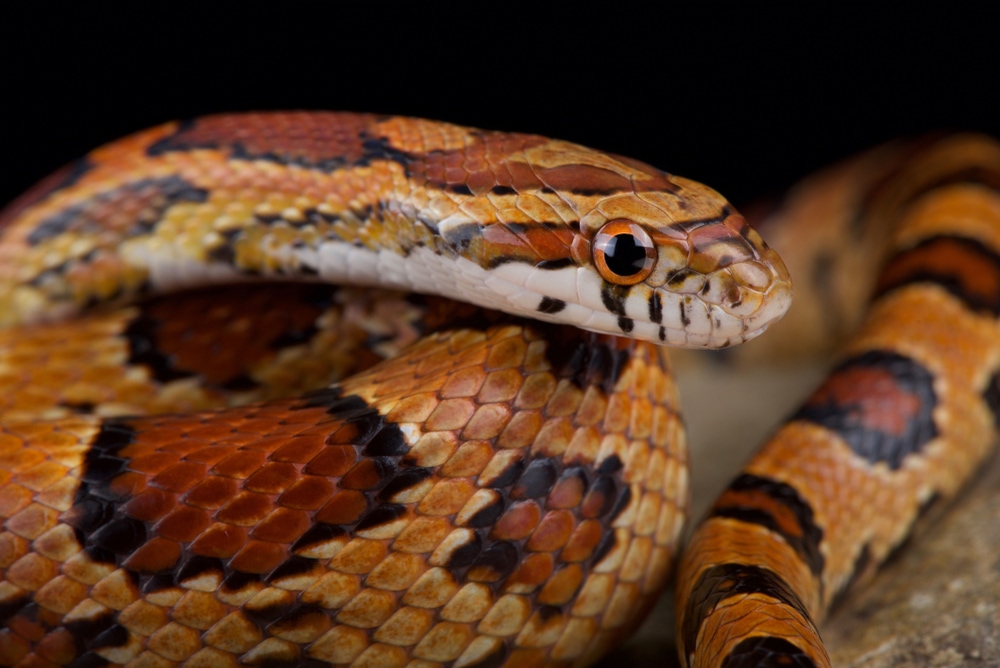Outforia Quicktake: Key Takeaways
- Corn snakes are beneficial to humans as they help control rodent populations.
- They are often mistaken for venomous copperheads but have no effective venom and are constrictors.
- Corn snakes are native to North America and inhabit various habitats, including woodlands, rocky areas, grasslands, barns, and abandoned buildings.
- They make excellent pets for beginner snake owners due to their docile nature and manageable size.
- Corn snakes are not on the IUCN Red List and face no significant population threats, except for humans killing them out of fear or misunderstanding.
For years, copper-colored snakes were found inside abandoned buildings, barns, and grain silos. Many have been killed because of how closely they resemble copperheads. Unfortunately, those snakes were much more beneficial to people than they knew.
Enter the corn snake. Corn snakes aren’t dangerous to people (though they can bite). Instead, they help eliminate rodent populations. Some people even keep corn snakes as pets!
Let’s dive into this cute, cuddly, and completely harmless snake species.
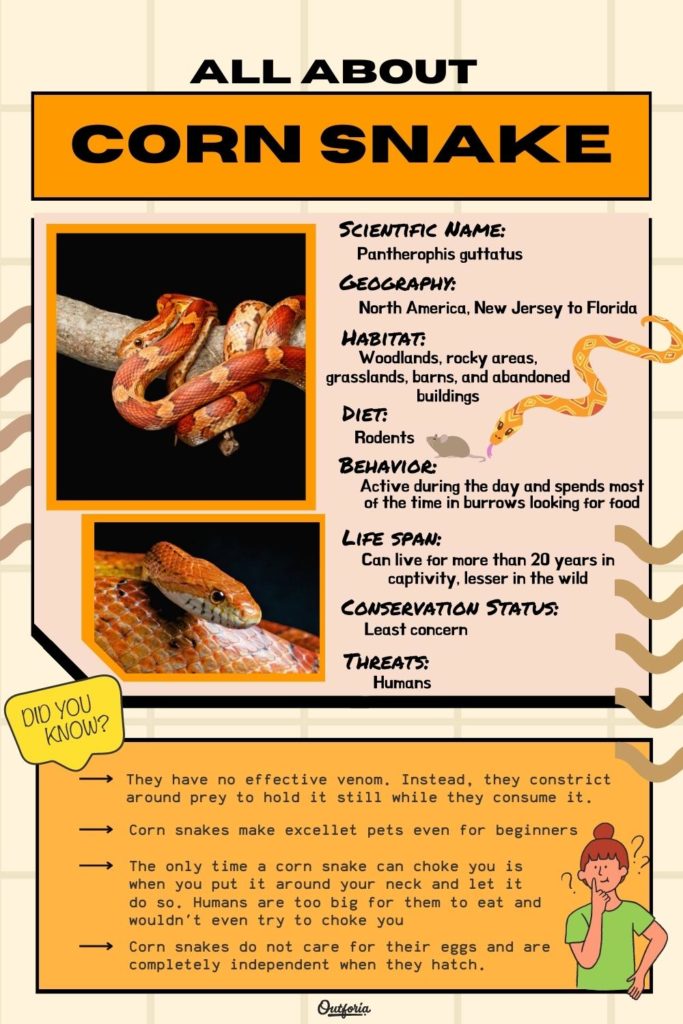
share this image on your site
<a href="https://outforia.com/corn-snake/"><img style="width:100%;" src="https://outforia.com/wp-content/uploads/2022/09/corn-snake-infographic-0922-683x1024.jpg"></a><br>corn snake <a href="https://outforia.com">Outforia</a>Corn Snake (Pantherophis guttatus)
Description

Corn snakes are often killed because they look similar to venomous copperheads. They tend to be reddish-brown with copper or yellow bands. They have slender bodies and heads.
On their belly, they have alternating rows of white and black. The name corn snake comes from two places. Their yellow markings sort of resemble kernels of corn. They’re also often found hiding in granaries and around grains like corn.
An average adult corn snake will reach a body length between 61–182 cm (2.00–5.97 ft). Despite looking like copperheads, corn snakes don’t have functional venom. Instead, they constrict around prey to hold it still while they consume it.
Native Range and Ideal Habitat
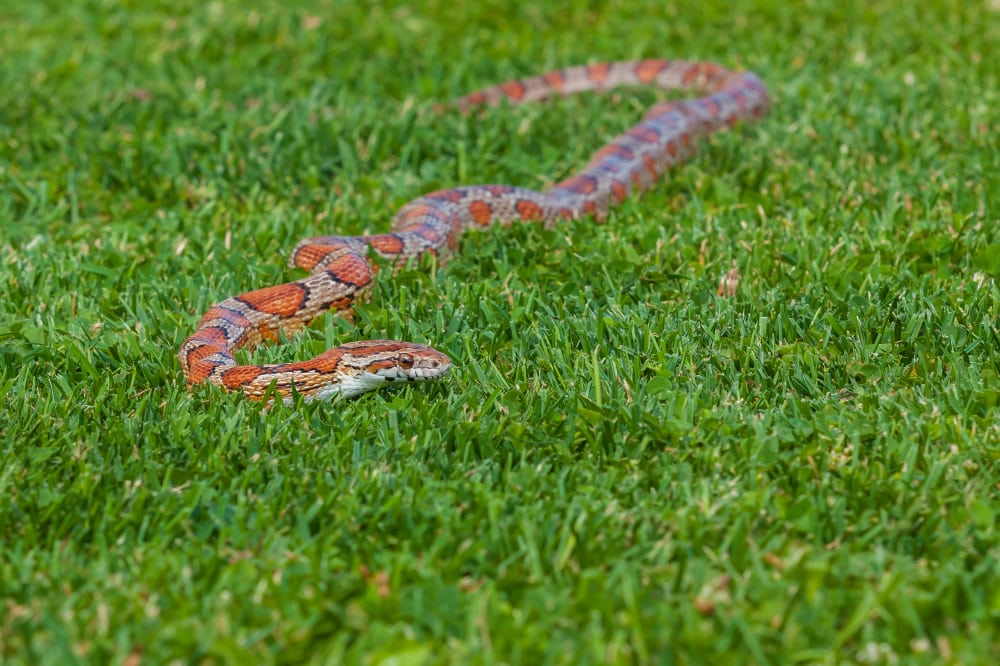
Corn snakes are native to North America. They can be found from southern New Jersey to Florida and as far east as the Mississippi River. Some populations were introduced to islands in the Caribbean for rodent control.
Corn snakes inhabit a wide variety of habitats. Woodlands, rocky areas, and grasslands are all places they can be found. You’ll most likely see a corn snake inside a barn or abandoned building.
You may also like: 25 Amazing Typowes of Snakes (Photos, Fun Facts & More!)
Diet and Behaviors
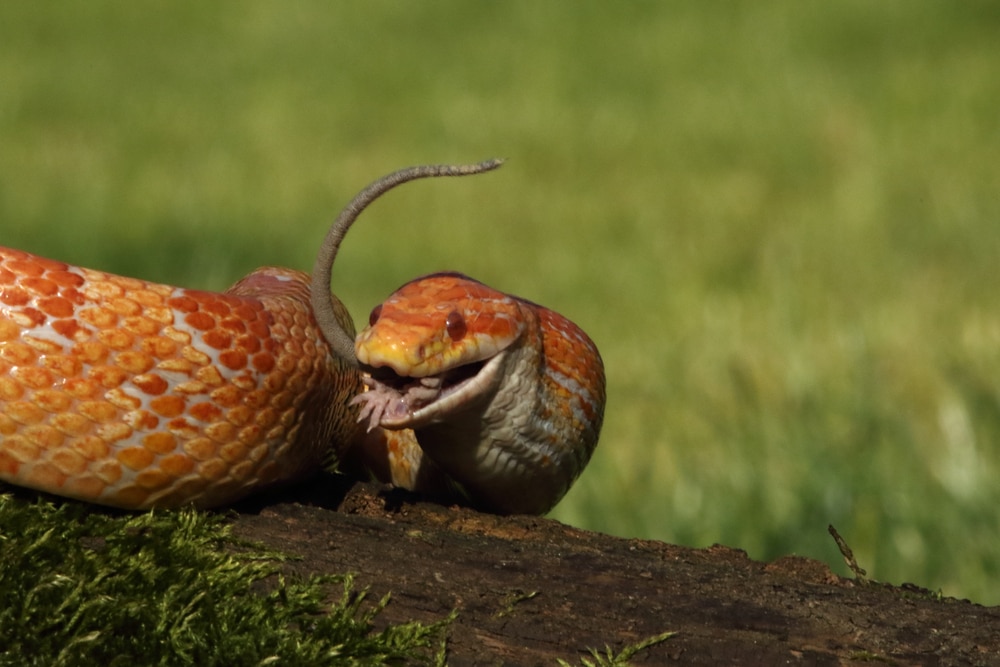
The bulk of a corn snake’s diet is rodents like rats and mice. This is why they can be found inside abandoned buildings and near grain silos. Those spots attract their favorite prey, so it also attracts corn snakes.
Juvenile corn snakes also feed on lizards and small frogs. Adults eat larger prey, including bats, birds, and rodents.
Without deadly venom, corn snakes still need a way to kill prey. They’re constrictors, just like pythons and boas. Corn snakes latch onto prey with their fangs, then coil their bodies around it. They squeeze the prey to death with their bodies before swallowing the prey whole.
On average, a corn snake needs to eat every few days. If they feel threatened, they vibrate their tails like rattlesnakes. There’s no rattle sound since they lack the skin folds rattlesnakes have.
Corn snakes are good climbers and can easily get up trees or into the rafters of a building. They’re most active during the day but are hard to find. Most of their time is spent slithering through rodent burrows in search of food.
Reproduction and Lifecycle
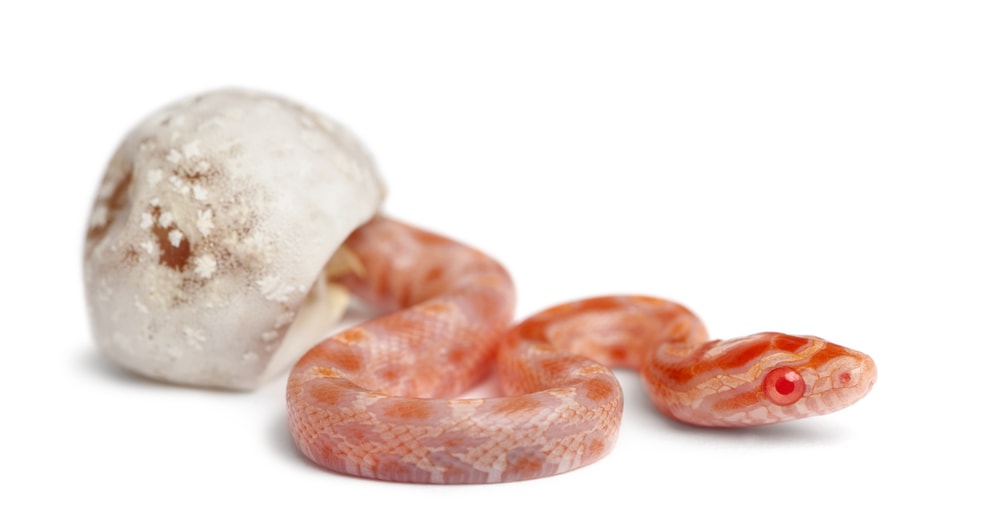
Corn snakes lay eggs in nests they make in rotting stumps, leaf piles, or decaying vegetation. These locations provide enough heat and humidity to incubate their eggs. Corn snakes do not care for their eggs and are completely independent when they hatch.
Female corn snakes lay a clutch of eggs numbering between 10 and 30. They incubate for 60-65 days and need to stay at 82 degrees Fahrenheit to hatch. At birth, corn snakes are around 25 to 38 centimeters (10 to 15 inches). It only takes them around 18 months to reach maturity.
In captivity, corn snakes can live for more than twenty years. In the wild, they usually live for much less time due to predation and access to food.
Corn snakes are eaten by animals like foxes, alligators, birds of prey, and wading birds.
Corn Snakes As Pets
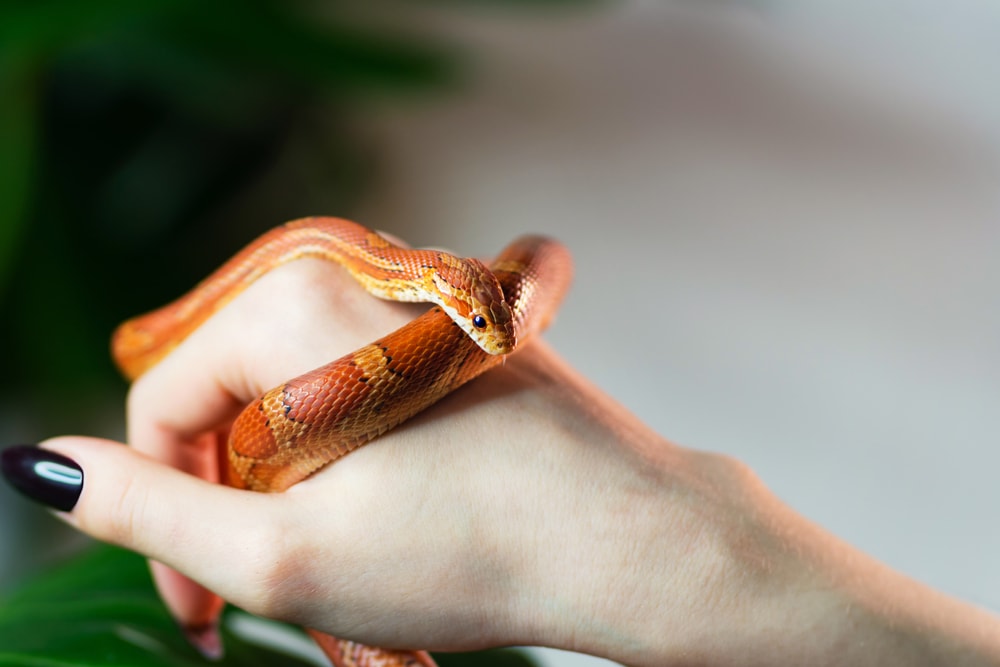
Unlike other species, corn snakes make excellent pets for beginner snake owners. They tend to be fairly docile and get used to being handled quickly. Corn snakes don’t grow too large and can be kept in reasonable enclosures.
You’ll need a very secure enclosure. Corn snakes, like all snakes, are very good at escaping their cage. They’ll push on all surfaces to look for tiny holes and can push the lid off the cage if it isn’t secure.
You’ll need at least a 20-gallon tank to house a corn snake. Give it plenty of places to hide so it can feel safe. A cardboard box can give it a nice spot, but you can also include limbs or store-bought hideaways.
Any pet reptile will need basking lamps to warm themselves under. You want to space them out so that the enclosure has areas of different temperatures.
Corn snakes love to dig and bury themselves. Your cage should have a layer of loose substrate that the corn snake can dig into. Inkless newspapers and soft wood shavings are a couple of good options.
You only need to feed an adult corn snake once every week or two. Thawed, frozen mice are the best food for them. Growing snakes can eat once every few days. The size of the food item should increase as the snake gets longer. You’ll also need a shallow water dish so the snake can drink water when needed.
Always select a captive-bred corn snake. Don’t try to tame a wild adult snake.
You may also like: 10 Most Venomous Australian Snakes In The World
Threats To Corn Snakes
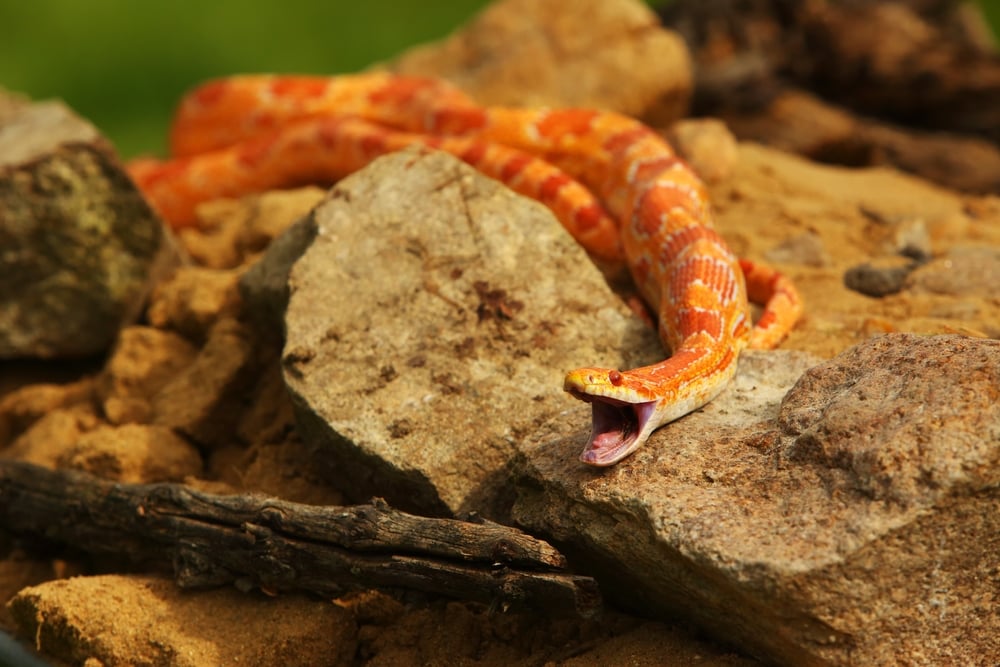
Corn snakes are not on the IUCN Red List and are considered a species of least concern. They breed easily and have healthy populations across their native ranges.
The largest threats to corn snakes are people. Most people kill snakes whenever they find them. It doesn’t matter that corn snakes are largely harmless.
Aside from people killing them, corn snakes don’t face many population threats.
Corn Snake FAQs
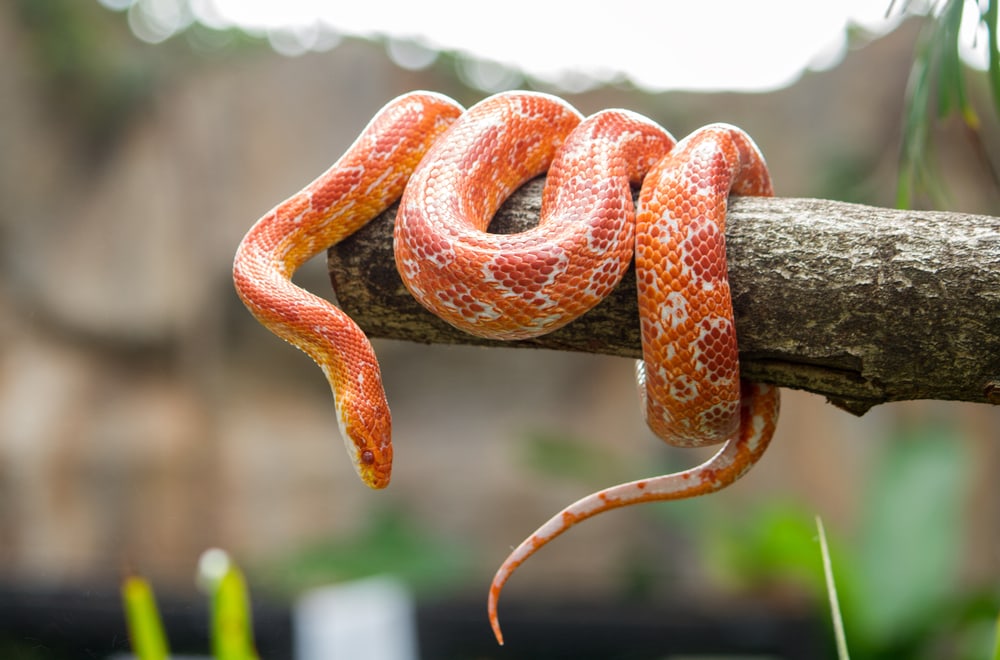
How Venomous Are Corn Snakes?
Corn snakes have no effective venom. Some snakes have venom that can paralyze small mammals like rats and mice. But they have no negative effects on humans.
Will a Corn Snake Bite You?
Like all snakes, corn snakes strike when cornered. In most cases, a corn snake will try to get away from you instead of biting. If it can find a way to get away, it will. That being said, if you grab a corn snake or corner it, expect it to try to bite you.
How Friendly Are Corn Snakes?
Overall, corn snakes are pretty friendly. Wild snakes will try to always avoid humans and hide most of the time. Captive corn snakes almost seem to like being handled. At least the ones who were conditioned to it early in life.
Can a Corn Snake Choke You?
A corn snake could choke you, but only if you put it around your neck and let it do so. The likeliest scenario is that the snake wouldn’t even try to choke you. People are way too big for corn snakes to eat, so they have no reason to try choking you.
More from Outforia
Learn more about these other amazing snake species!




